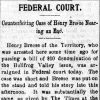calsfoundation@cals.org
Panic of 1893
In 1893, a national financial crisis led to the closing of businesses and banks in Arkansas. The crisis in banking ended with the repeal of the Sherman Silver Purchase Act late in 1893. The depression continued until 1897. During this period, agricultural prices declined steeply in the state.
Even before the panic, financial markets were not sound, and the state’s economy was moribund. In 1891, the legislature voted to postpone funding of the state’s representation at the Columbian Exposition in Chicago and never returned to the issue. Arkansas’s participation was instead privately funded by the Little Rock Board of Trade. On January 18, 1893, the Arkansas Gazette reported “a financial flurry” in response to a run on First National Bank in Little Rock (Pulaski County). The article described how prominent bankers Colonel George F. Baucum, Charles F. Penzel, Oscar Davis, and William B. Worthen carried a large amount of gold and greenbacks (silver notes) into First National Bank, where “speculators and anxious depositors” had gathered. The bankers displayed these liquid assets to prevent a bank run and as a way of proving their solvency.
The collapse of the Philadelphia and Reading Railroad in February has been cited as the beginning of the panic and the first in a series of economic upheavals that would leave the economy in a depression until 1897. The railroads had created an economic bubble by investing and building beyond what could be utilized. This was followed by the failure of the National Cordage Company, which began in 1893 with 100 percent stock dividend and ten percent annual payments and rapidly went into receivership. Such high-profile business failures outside of the financial center likely caused the panic. The panic entered a second phase when the suspension of banking in New York spread to the rest of the country.
In The Robber Barons, Matthew Josephson described the financial crisis as a “rich men’s panic” in that it was the “expropriation of pygmy capitals by giant capitals.” These great fortunes—those of the Rockefeller, Vanderbilt, and Morgan families—were located outside of Arkansas, but the business owners and farmers of Arkansas were not protected from the economic downturn.
Over 500 banks in the nation failed over the course of the panic, including Little Rock’s First National Bank. The banks failed because of the decline in National Cordage stock. On May 5, 1893, the New York Stock Exchange crashed. The Gazette headlined the news: “Wall Street Topsy-Turvy, The Famous ‘Street’ Passes Another Eventful Black Friday.” According to the article, “It is said at the Treasury that the time has passed when the Government can aid Wall Street.” John Gould Fletcher wrote of the panic: “Such were the nineties, now qualified as being ‘gay’ but in reality marked in the North and the East by violent labor disturbances and huge financial panics. Of these Arkansas heard very little; though perhaps the famed panic of 1893 was responsible for the fact that three years later in Little Rock eggs sold at eight cents a dozen, breakfast bacon was only ten cents a pound, and cotton was seven and a half cents a pound!”
On June 27, there was another crash of the New York Stock Exchange, and the nation was left without a system of credit. As stocks fell, people exchanged greenbacks for gold. The U.S. Treasury became unable to give people gold in exchange for currency, which compounded the crisis, as the treasury was required by the Sherman Silver Purchase Act to provide silver or gold in exchange for these notes. In response to the panic, Congress repealed the Sherman Silver Purchase Act late in 1893. The repeal of this act caused a steep decline in the value of silver and gold. This led to the closing of silver mines and related financial losses. In Arkansas, the idea of silver-based currency became increasingly popular, especially in rural areas. Those who favored the gold standard fell from favor, and in 1896, the pro-silver candidate, William Jennings Bryan, carried the state.
Before the Depression of the 1930s, the period from 1893 to 1896 had been called the Great Depression. Crop prices fell, wages shrunk, and an estimated 15,000 businesses went bankrupt. Arkansas businesses lost an estimated $35 million. Anger fueled increased violence toward African Americans, given that a financial crisis had the ability to undermine the racial power structure. An account of the effects of the panic is found in a historical account of Central Presbyterian Church in Fort Smith (Sebastian County): “Cumberland’s chances of completing a new church in 1893 were dashed when a stock market panic and then recession swept across the country. Money became scarce and building activity slowed. Even in Fort Smith, property values tumbled almost overnight.”
For additional information:
“The Busted Bank.” Arkansas Gazette. February 3, 1893, p. 1.
Carlson, Mark. “Causes of Bank Suspensions in the Panic of 1893.” http://www.federalreserve.gov/Pubs/feds/2002/200211/200211pap.pdf (accessed January 26, 2023).
“A Financial Flurry.” Arkansas Gazette. January 18, 1893, p. 2.
Josephson, Matthew. The Robber Barons. New York: Harcourt Brace Jovanovich, 1990.
Niswonger, Richard L. “Arkansas and the Election of 1896.” Arkansas Historical Quarterly 34 (Spring 1975): 41–78.
Allen McMillan
Little Rock, Arkansas


 Board of Trade Building
Board of Trade Building  First National Bank
First National Bank 



Comments
No comments on this entry yet.